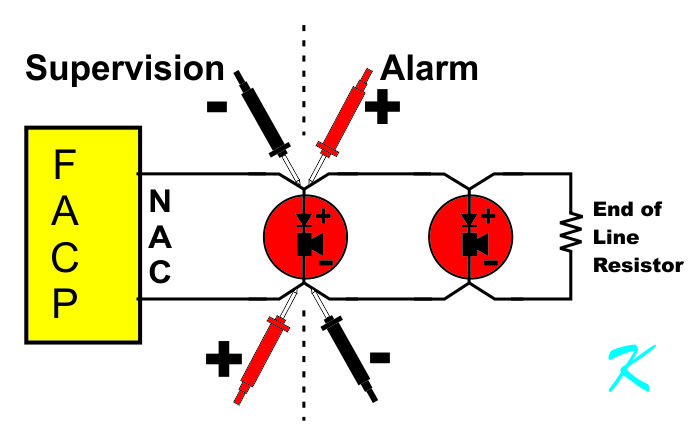Some background is needed to understand what should be done to find the problem and fix it.
You have to be very careful about using the words "Wireless" and "Addressable" when describing a fire alarm system. Also, be aware that many wireless fire alarm systems and many addressable fire alarm systems use conventionally wired Notification Appliance Circuits (NACs).
Rather than really describing the type of fire alarm control panel that's being used, the words "Conventional", "Addressable", "Wireless", and "Notification Appliance Circuit (NAC)" describe the circuits outside the fire alarm panel. I know because some of the fire alarm control panels that I've programmed are capable of using all of these circuits at once.
"Conventional" describes fire alarm DC signaling input circuits (IDC), and fire alarm DC output circuits powering the horns, strobes, strobes, chimes, etc. N(NAC).
"Addressable" describes that a short digital address has been added to the beginning of a digital signal by the sending equipment, in order to direct the signal to the proper receiving equipment.
Internet signals are all addressed with an IP number; networking signals between fire alarm control panels have an address attached to the data; fire alarm Signaling Line Circuits (SLC) have addresses attached to the data; wireless fire alarm systems have addresses attached to the data.
"Wireless" describes that the wires that carry signals have been replaced with Radio Frequency (RF) signals.
A wireless telephone has a base and a handset. The signals between the two are sent RF, while the power for the base comes from the electrical wall outlet, and the power for the handset comes from an internal battery.
A wireless fire alarm system has a control panel is addressable and has a signal receiver (sometimes also a transmitter). It uses utility power and a standby battery for power. The wireless devices (switches, modules, and detectors) are addressable, and have signal transmitter (sometimes also a receiver). They use internal batteries for power.
Notification Appliance Circuit (NAC) describes a conventional fire alarm circuit that carries power to the horns, strobes, bells, chimes, etc., sounding the alarm.
Looking at a NAC circuit a different way, all that the NAC circuit does is to turn on or turn off power to the horn or strobe. If the power is turned off, the horns and strobes don't make noise or flash, if the power is turned on, the horns make noise and the strobes flash.
In the past 40 or so years, there have been synchronizing signals added to the power signals of the standard NAC. These signals vastly vary from one manufacturer to another manufacture, but with almost all of these synchronizing signals, a hand-held voltmeter won't detect them.
The biggest concern with the added signals is that they are customized for a specific manufacturer. Make sure the non-working horns and strobes are the same brand as the working ones on the second floor. Trying to use different brands could cause some of them fail to work.
Two Conditions - Supervisory and Alarm
Inside the fire alarm horns, stoves, chimes, bells, etc. is a blocking diode. Dependent on which way the current is trying to move, the diode blocks the current from flowing, or the diode allows the current to freely flow through the device.
The polarity of the voltage on the terminals of the device determines the direction of current through the device.

In other words, the polarity of the voltage pushing the current through the device is important, and it's easy to measure the voltage at the device.
Here's the interesting part, though. The result of the voltage measurement depends on when the measurement takes place.
Supervision Time is when the fire alarm control panel is normal, not sounding the alarms. During supervision time, the voltage measurement will be
negative on the
plus terminal and
positive on the
minus terminal.
Alarm Time is when the fire alarm system is in "Fire Alarm" mode, sounding the alarms. During alarm time, the voltage measurement will be
positive on the
plus terminal and
negative on the
minus terminal.
Because it's a conventional circuit, the panel probably won't tell you if a horn or strobe is wired in backwards. You can only find out through testing to see if the horn makes noise and the strobe flashes.
If all of the horns and strobes on the circuit are wired backwards, possibly the problem is the polarity of the circuit at the fire alarm control panel or NAC booster power supply for the circuit. That would be the next place to check.
Douglas Krantz


